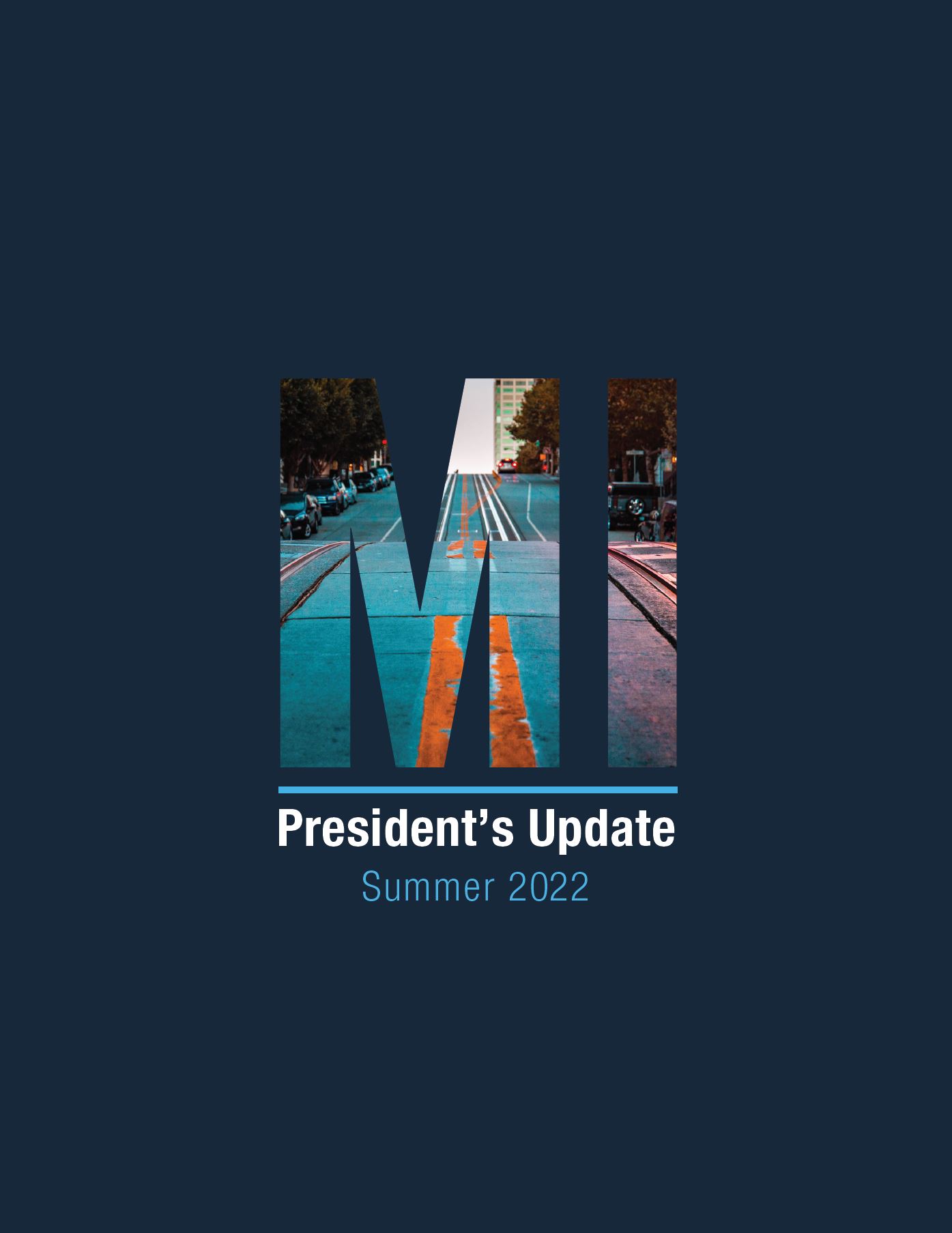President’s Update: Summer 2022

DEAR FRIENDS AND SUPPORTERS,
Vladimir Putin’s invasion of Ukraine has forced Americans to confront the consequences of years of misguided energy policies. On both sides of the Atlantic, bans on fracking, the shuttering of nuclear power plants, and the failure to permit new pipelines and terminals have increased Western strategic dependence on oil and gas from Russia, a point underscored dramatically by recent price shocks to fuel and food. And with the U.S. economy already reeling from inflation driven by excessive fiscal expansion, accommodative monetary policy, and supply-chain constraints, it is increasingly clear that the Biden administration’s early commitment to shrinking domestic oil and gas production was a costly mistake. Navigating the ongoing turmoil will require a renewed commitment to American energy leadership, fiscal and monetary restraint, and an emphasis on supply-side economic reform—policy measures on which Manhattan Institute fellows are poised to lead the way.
“Navigating the ongoing turmoil will require a renewed commitment to American energy leadership, fiscal and monetary restraint, and an emphasis on supply-side economic reform—policy measures on which Manhattan Institute fellows are poised to lead the way.”
Writing in City Journal, senior fellow Mark Mills called for a Great Energy Reset, an acknowledgment that oil and gas will be vital to the world’s energy needs for the foreseeable future. Mills argues that, by making credible policy commitments today, U.S. policymakers can ensure that our shale fields play a major role in alleviating geopolitical risk, driving down prices, and boosting economic growth. While such a reset would not mean abandoning alternative energy development, it would mean adding the removal of barriers to hydrocarbon production to the broader set of policies designed to foster energy abundance.
In April, Mills hosted Pulitzer Prize winner and IHS Markit vice chairman Daniel Yergin for a virtual event, “Will the Ukraine Crisis Spark the Great Energy Reset?” Mills also took to the opinion page of the Wall Street Journal to point out that simply doubling down on green-energy mandates will further fuel inflation by stoking demand for metals and other commodities while continuing to constrain the supply of hydrocarbon-based energy.
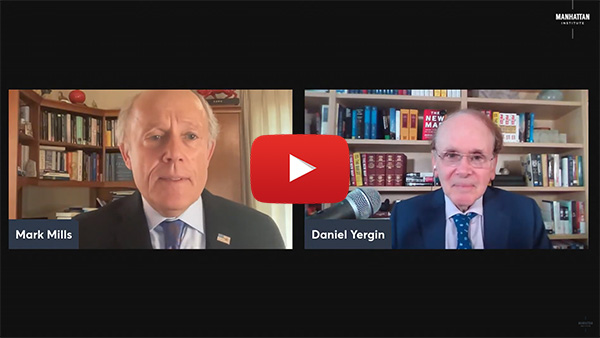
One reason the U.S. can unilaterally reshape energy geopolitics is that maturing technologies such as machine learning, artificial intelligence, and robotics are now poised to revolutionize not just the energy industry but the broader economy. In his new podcast, “The Last Optimist,” Mills explores a wide range of such technologies, describing their tremendous economic potential and the public policies necessary to unleash it. In a forthcoming report, Mills explains how, if policy permits, such technologies can reset energy economics and geopolitics for the next half-century, building on the already unprecedented increase in America’s oil and gas production over the past two decades.
While a credible recommitment to American energy independence would alleviate inflationary pressure, addressing the highest inflation rate in decades will require more than just energy policy. Writing in the Wall Street Journal in March, MI Shadow Open Market Committee member Mickey Levy made the case for tightening monetary policy. Levy called for an end to accommodation and a course of consistent rate increases at coming meetings of the Federal Open Market Committee, pushing back on the rosy outlook for inflation that Fed chairman Jerome Powell provided during his testimony to Congress earlier in the month. In April, senior fellow Allison Schrager hosted SOMC members for a public discussion of the Fed’s inflation challenge on how best to confront it, including remarks from three former presidents of Federal Reserve district banks: William Dudley (New York), Jeffrey Lacker (Richmond), and Charles Plosser (Philadelphia).

Writing in the Washington Post, senior fellow Brian Riedl pointed out that the fiscal excesses of the Biden administration—namely, the $1.9 trillion American Rescue Plan (ARP) that was enacted in March 2021—were further fueling inflation. Riedl argued that lawmakers should look for options to pare back remaining ARP spending and strenuously resist further overtures from the administration to pass lavish spending bills like Build Back Better—fiscal guidance that is doubly important now that the Fed is raising rates in pursuit of a soft landing.
The stakes for containing inflation and inflation expectations are high. Should the Fed falter, sustained price volatility could lead borrowers to demand a higher inflation-risk premium, increasing the interest costs of servicing the national debt and risking a broader crisis. This is one of several scenarios that Riedl explores in his recent report “How Higher Interest Rates Could Push Washington Toward a Federal Debt Crisis.”
“Senior fellow Brian Riedl pointed out that the fiscal excesses of the Biden administration—namely, the $1.9 trillion American Rescue Plan (ARP) that was enacted in March 2021—were further fueling inflation.”
With the U.S. government already poised to run a staggering $112 trillion in budget deficits over the next three decades, due largely to Social Security and Medicare commitments, debt doves can no longer push ever more aggressive expansions of federal spending on the assumption that interest rates will never rise above 3% or 4%. Even without lavish spending on new entitlements, the risk of a debt crisis from higher rates is real. To avoid it, Riedl calls on lawmakers to avoid large new spending bills, to enact reforms that reduce the costs and budget shortfalls associated with Social Security and Medicare, and to begin to lock more of the federal debt—which, at an average maturity of just 69 months, leaves Washington vulnerable to higher interest rates down the road—into long-term fixed interest rates.
Cancel Culture and Identity Politics
Recent geopolitical and economic tumult notwithstanding, Americans continue to express concern over the rise of speech restrictions and radical identity politics in government, media, education, business, and the arts—a debate in which the work of MI fellows plays a critical role. In recent survey work, Birkbeck College professor and MI adjunct fellow Eric Kaufmann found that a majority of Americans oppose cancel culture but that a significant minority—about a third—support it, backing decisions to fire employees for legal speech that they regard as unacceptable. He finds that views on cancel culture divide the Democratic coalition while uniting Republicans. What’s more, Kaufmann predicts that the problem of cancel culture will get worse before it gets better because younger people are substantially more likely to support cancellation than older Americans, even after controlling for ideology and political party affiliation.
 Echoing the results of MI’s Metropolitan Majority polling last fall, Kaufmann found that an overwhelming majority of voters of all political stripes oppose certain teaching methods inspired by Critical Race Theory (CRT), such as separating children by race into “privileged” or “oppressed.” This broad resistance to implementing CRT-inspired notions of race essentialism in K–12 classrooms is evident from a variety of state-level legislative efforts around the country. In December, MI fellows Christopher Rufo, James Copland, and John Ketcham published “A Model for Transparency in School Training and Curriculum”—an approach that would allow families, teachers, and schools to better negotiate disagreements over controversial curricular elements by ensuring that parents have reasonable access to the instructional, training, and learning materials used by their local public schools. After dozens of briefings with public officials around the country, curriculum transparency is now on the legislative agenda in numerous states—notably, in states like Iowa and Missouri, where, as of this writing, transparency measures were making their way through the legislature, along with Florida, where Governor DeSantis signed curriculum transparency into law on March 25.
Echoing the results of MI’s Metropolitan Majority polling last fall, Kaufmann found that an overwhelming majority of voters of all political stripes oppose certain teaching methods inspired by Critical Race Theory (CRT), such as separating children by race into “privileged” or “oppressed.” This broad resistance to implementing CRT-inspired notions of race essentialism in K–12 classrooms is evident from a variety of state-level legislative efforts around the country. In December, MI fellows Christopher Rufo, James Copland, and John Ketcham published “A Model for Transparency in School Training and Curriculum”—an approach that would allow families, teachers, and schools to better negotiate disagreements over controversial curricular elements by ensuring that parents have reasonable access to the instructional, training, and learning materials used by their local public schools. After dozens of briefings with public officials around the country, curriculum transparency is now on the legislative agenda in numerous states—notably, in states like Iowa and Missouri, where, as of this writing, transparency measures were making their way through the legislature, along with Florida, where Governor DeSantis signed curriculum transparency into law on March 25.
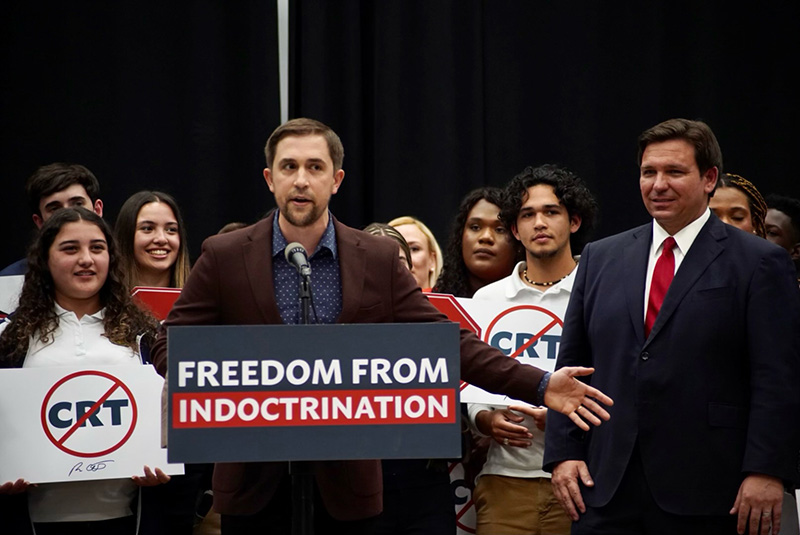
But it was a different bill in Florida, the Parental Rights in Education law, that thrust the state and its governor into the national spotlight in March. Labeled “Don’t Say Gay” by its opponents, the law involves two primary measures. First, it prevents classroom instruction on sexual orientation or gender identity in grades kindergarten through three. Second, it prevents schools from prohibiting parental involvement in critical decisions affecting a student’s mental, emotional, or physical well-being. While critics charge that the law is homophobic and anti-trans, MI fellow Leor Sapir argued that the bill’s derisive “Don’t Say Gay” moniker is actually a more appropriate description of the way that many schools currently approach transgender policy—policies that inadvertently encourage children with same-sex attraction to interpret their as-yet-unsettled feelings as evidence of being trans. By requiring parental involvement, Sapir argues, the Florida law offers a check on schools that might otherwise rush into gender-affirming procedures for children who exhibit symptoms of gender dysphoria. As Sapir’s writing for City Journal demonstrates, such legislative remedies are likely to become more commonplace where transgender activism pushes law and policy well beyond the available scientific evidence, from pediatric gender-transition medicine to the participation of transgender girls and women in female sports.

Divisive identity politics may have their origins in America’s educational institutions, but their reach is not limited to schools and universities. As Heather Mac Donald has capably documented in the pages of City Journal, museums and other cultural organizations are now considering their missions through a simplistic racialist lens, with institutions such as the Metropolitan Museum of Art recasting entire traditions in humanities, music, and the arts as part of a Western past defined by white oppression. In one particularly egregious example, the Art Institute of Chicago recently eliminated its program for 82 docents—volunteers dedicated to educating the museum’s visitors about its collections—because the corps, predominantly older white women, was “insufficiently diverse.” As Mac Donald points out, the embrace of race essentialism in the arts is bound to take a toll: aside from turning away volunteers on the basis of race, museums that label as “repressive” the art forms that they were established to preserve will actively discourage potential patrons and practitioners, compromising the continuity of artistic traditions for generations to come.
Urban Policy: Challenges in New York City and Beyond
Among the challenges facing the cultural institutions and the cities they call home is the ongoing increase in violent crime. In March, two clerks at the Museum of Modern Art were stabbed by an apparently mentally ill man whose membership to the museum had been revoked previously because of repeated disruptive behavior. The attack was part of a string of violent crimes involving mentally ill offenders in New York City, the most terrifying of which occurred on April 12 in a Sunset Park subway station, when Frank James is alleged to have shot 10 people in an incident that injured 22, a number of children among them. The attacks were yet another grave reminder that NYC has considerable work to do in addressing serious mental illness and fighting violent crime, not least on the transit system that so many rely on to move about the city.
In February, senior fellow Stephen Eide published “Crime and Mental Illness in New York City: Framing the Challenge for the New Mayor,” in which he offered several recommendations for reducing the criminal involvement of people with serious mental illness, including ending the citywide reduction of inpatient psychiatric beds and increasing the use of outpatient civil commitment. Later that month, senior fellow Rafael Mangual joined former New York City Police commissioner William Bratton on the Wall Street Journal op-ed page, pointing out that New York is now the only state in which judges cannot remand dangerous defendants to pretrial detention based on the danger they pose, and urging Albany to further amend its misguided bail-reform efforts with public safety in mind. In the New York Times, Hannah Meyers, director of MI’s Policing and Public Safety Initiative (PPSI), joined Jim Quinn, former executive assistant district attorney in Queens, to make the case that overreaching criminal-justice reforms, justified on grounds that they would reduce the impact of the criminal justice system on black New Yorkers, were actually harming black communities by exposing them to greater rates of victimization.
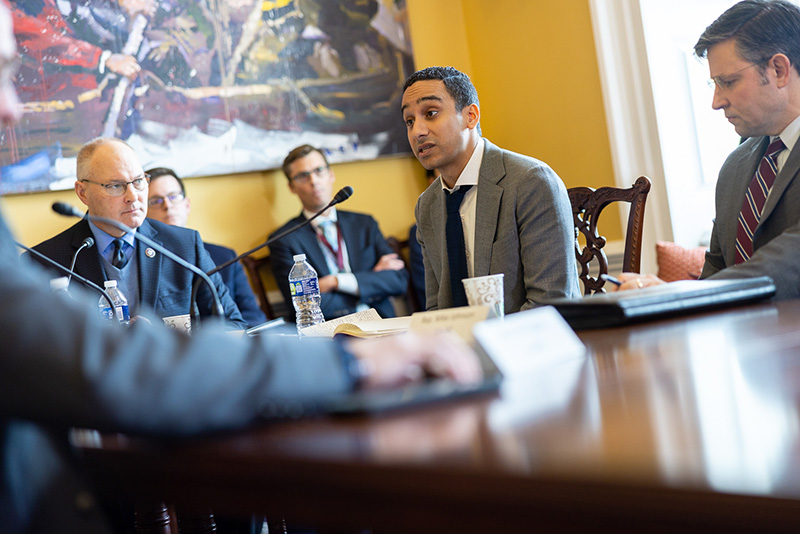
In March, fellow Charles Lehman published “Understanding and Reducing Hate Crimes in New York City.” Lehman observes that, at the end of 2021, hate-crime offenses in NYC were on par with levels not seen since the 1990s, with distinct spikes in anti-Asian and anti-Semitic hate crimes in recent years. To combat such crimes, Lehman suggests a policy of focused deterrence and zero tolerance: making a public commitment to deploying additional police resources to areas with the greatest risk for such offenses and following through on arrests by prosecuting offenders to the fullest extent of the law.
“To restore public faith in the safety of the system and to encourage greater ridership, police must return to proactive and preventive policing in the subway system, and prosecutors need to follow through on the resulting arrests—including the prosecution of chronic fare evasion.”
Later in March, senior fellow Nicole Gelinas published “Public Safety on NYC Subways: No Safety in Small Numbers,” a report that updates her important work on subway crime trends from the summer of 2021. Gelinas finds that subway ridership, though still well below the pre-pandemic normal, has risen but that violent crime on the transit system remains stubbornly high. Gelinas notes that Governor Hochul and Mayor Adams announced a plan to secure the subways in January, one that focuses on improved mental health treatment. While the plan is a step in the right direction, Gelinas calls on them to go further. To restore public faith in the safety of the system and to encourage greater ridership, police must return to proactive and preventive policing in the subway system, and prosecutors need to follow through on the resulting arrests—including the prosecution of chronic fare evasion.
Gelinas’s report raises a critical point in the broader discussion of public safety in American cities: police cannot do it alone. In addition to a focus on treating serious mental illness, cities need prosecutors to do their jobs. In too many instances—from Chesa Boudin in San Francisco to Larry Krasner in Philadelphia to Alvin Bragg in Manhattan—progressive prosecutors are doing the opposite, making an ideologically motivated push for decarceration through the non-prosecution of serious criminal offenses and dangerous criminal offenders. Drawing on our Policing and Public Safety Initiative’s growing network of scholars, journalists, prosecutors, and law enforcement, MI has played a central role in resisting progressive prosecution.
In January, MI hosted “Manhattan DA Bragg and the Future of NYC Crime,” a virtual event in which senior fellow Rafael Mangual moderated a discussion on the consequences of progressive prosecution policies between former Queens prosecutor Jim Quinn and Thomas Hogan, former district attorney for Chester County, Pennsylvania. Hogan, who writes regularly on prosecution and criminal justice for City Journal, joined MI as an adjunct fellow in April. Joan Illuzzi-Orbon, a 33-year veteran of the Manhattan district attorney’s office, joined MI as a fellow in April as well. Illuzzi-Orbon served most recently as executive assistant district attorney and chief of the trial division. She tried some of the office’s most complex and high-profile cases, including the kidnapping and murder of six-year-old Etan Patz 30 years after his disappearance and, most recently, the prosecution of Hollywood producer Harvey Weinstein. As an MI fellow, Illuzzi-Orbon will make use of media appearances, events, and written commentary to advocate for the sorts of prosecution strategies that can effectively contribute to crime control in New York and other cities.
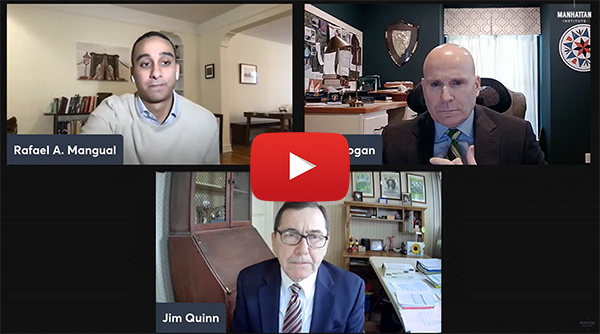
The extent to which New York City is successful on public safety and other important issues, such as education, will ultimately depend on the willingness of officials outside city government—in district attorney’s offices and Albany—to be effective partners, but considerable room remains for optimism about the welcome change in direction ushered in by the Adams administration. On April 6, as part of its Klinsky Leadership series, MI hosted “The First 100 Days of Adams (and the Future of New York City),” an all-day event tackling topics such as crime, education, road safety, and economic development, featuring remarks from Congressman Ritchie Torres and Errol Louis of NY1 and New York Magazine, as well as a closing discussion between senior fellow Jason Riley and former NYC schools chancellor Joel Klein.

As Mayor Adams’s own schools chancellor, David Banks, has made clear, the new administration represents a return to the ideas that guided education policy during the Bloomberg era: that New York City has an obligation to expand the number of high-quality educational opportunities available to parents and students across the city, be they in district schools, charters, or private schools.
As always, a commitment to educational pluralism and high-quality schooling are hallmarks of MI’s work on education policy. For example, in January, senior fellow Ray Domanico, director of MI’s education policy team, published “The Transformation of Public High Schools in New York City,” demonstrating that the city’s efforts to replace failing schools with new district and charter high schools paid significant dividends, and can once again serve as a model for improving schools under Mayor Adams. More recently, Domanico and Wai Wah Chin, an adjunct fellow and the founding president of the Chinese American Citizens Alliance of Greater New York, have called on Albany to lift the charter cap that deprives many NYC parents and students of better educational opportunity. Whether Albany heeds the call is another matter, but with the 2022 gubernatorial race beginning to heat up, MI intends to keep education reform and other matters such as energy, public safety, and housing squarely in the public eye.

The challenges faced by New York City and the United States are formidable. But as I hope this update thoroughly illustrates, MI and its fellows are at the forefront of the nation’s most urgent policy debates. We are immensely grateful for your support, and we continue to rely on your generosity to advance ideas that further economic opportunity, individual liberty, and the rule of law in America and its great cities. I wish you and your loved ones a wonderful summer.
Reihan Salam
President, Manhattan Institute

Are you interested in supporting the Manhattan Institute’s public-interest research and journalism? As a 501(c)(3) nonprofit, donations in support of MI and its scholars’ work are fully tax-deductible as provided by law (EIN #13-2912529).
